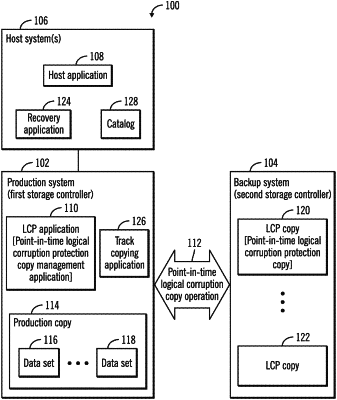| CPC G06F 11/1446 (2013.01) [G06F 2201/80 (2013.01)] | 20 Claims |

|
1. A method, comprising:
communicating, from a host system, to a production system that performs point-in-time copy operations to a backup system to generate a logical corruption protection (LCP) copy of a production copy that comprises a data set, wherein the data set is stored in the production system and the LCP copy is stored in the backup system, and wherein the point-in-time copy operations do not use information on the data set or file structure that is included in a media on which the data set is stored; and
in response to a detection of a logical corruption in the data set, recovering, by a recovery application executing in the host system, the data set from the LCP copy, wherein without using the recovery application and the LCP copy, the production system is unable to recover from the logical corruption in the data set without copying an entirety of one or more volumes from the backup system to the production system, wherein only tracks of the data set that is corrupted are copied from the LCP copy by the recovery application, and wherein the recovering of the data set from the LCP copy further comprises:
quiescing the data set in the production system and the LCP copy in the backup system, prior to transmitting of a query to a catalog in the host system, to determine a set of logical devices in the production system in which the data set resides; and
releasing the quiescing of the data set and the LCP copy, subsequent to performing a physical track copying of associated physical tracks corresponding to the data set from the LCP copy to the production copy for the set of logical devices in the production system.
|